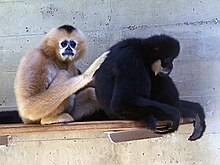
Gibbons are apes in the family Hylobatidae. The family historically contained one genus, but now is split into four extant genera and 20 species. Gibbons live in subtropical and tropical rainforest from eastern Bangladesh to Northeast India to southern China and Indonesia.

Apes are a clade of Old World simians native to Africa and Southeast Asia, which together with its sister group Cercopithecidae form the catarrhine clade. Apes do not have tails due to a mutation of the TBXT gene. In traditional and non-scientific use, the term "ape" can include tailless primates taxonomically considered Cercopithecidae, and is thus not equivalent to the scientific taxon Hominoidea. There are two extant branches of the superfamily Hominoidea: the gibbons, or lesser apes; and the hominids, or great apes.
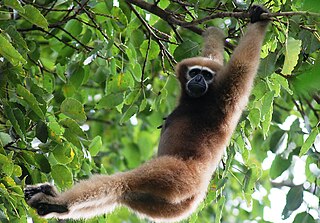
The hoolock gibbons are three primate species of genus Hoolock in the gibbon family, Hylobatidae, native to eastern Bangladesh, Northeast India, Myanmar, and Southwest China.

Nomascus is the second-most speciose genus of gibbons. Originally, this genus was a subgenus of Hylobates, and all individuals were considered one species, Hylobates concolor. Species within Nomascus are characterized by 52 chromosomes. Some species are all black, some are light with a distinct black tuft of crown fur, and some have distinct, light-colored cheek patches. Nomascus is found from southern China (Yunnan) to southern Vietnam, and also on Hainan Island. One species, Nomascus nasutus, has been deemed "the most critically endangered ape species in the world". All species in this genus are either endangered or critically endangered.

The Hatinh langur is a highly threatened Old World monkey found in limestone forests in Vietnam, primarily in the Quảng Bình Province. A recent survey discovered a small population living in the Quảng Trị Province. Contrary to its name, it is not known from the Hà Tĩnh Province. The local Van Kieu minority refer to this lutung as the 'Con Cung', which roughly translates as "black, cliff-dwelling monkey with a long tail". It resembles the closely related François' langur, but its white cheek-stripes typically extend behind the ears onto the nape, and the overall black colour is non-glossy and has a brownish tinge.
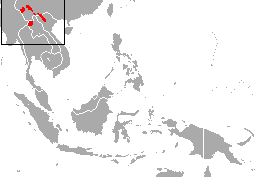
The black crested gibbon is a Critically Endangered species of gibbon found in China, Laos, and northern Vietnam, with four subspecies.
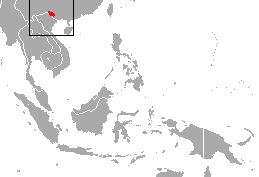
The eastern black-crested gibbon, also known as the Cao-vit black crested gibbon or the Cao-vit crested gibbon, is a species of gibbon from southeast China and northern Vietnam. The term "Cao-vit" originated from the sounds of their calls or songs that villagers of Ngoc Khe, Phong Nam and Ngoc Con communes of Trung Khanh District, Cao Bang Province of Vietnam use to name for them. This name was officially used by gibbon experts since the rediscovery.

The grey-shanked douc langur is a douc species native to the Vietnamese provinces of Quảng Nam, Quảng Ngãi, Bình Định, Kon Tum, and Gia Lai. The total population was estimated at 550 to 700 individuals in 2004. In 2016, Dr. Benjamin Rawson, Country Director of Fauna & Flora International's Vietnam Programme, announced a discovery of an additional population including more than 500 individuals found in Central Vietnam, bringing the total population up to approximately 1000 individuals.

Delacour's langur or Delacour's lutung is a critically endangered species of lutung endemic to northern Vietnam. It is named for French-American ornithologist Jean Théodore Delacour.
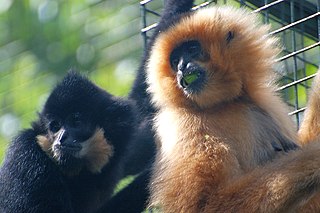
The yellow-cheeked gibbon, also called the golden-cheeked gibbon, the yellow-cheeked crested gibbon, the golden-cheeked crested gibbon, the red-cheeked gibbon, or the buffed-cheeked gibbon, is a species of gibbon native to Vietnam, Laos, and Cambodia. The species was discovered and named after the British naturalist Gabrielle Maud Vassal.
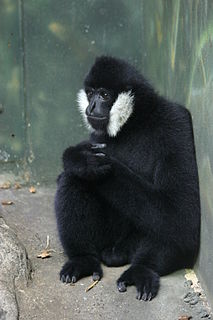
The northern white-cheeked gibbon is a Critically Endangered species of gibbon native to South East Asia. It is closely related to the southern white-cheeked gibbon, with which it was previously considered conspecific. The females of the two species are virtually indistinguishable in appearance.
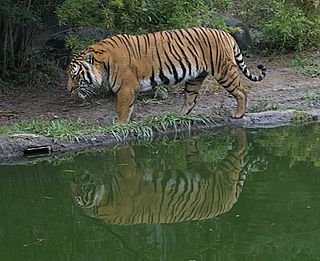
The wildlife of Laos encompasses the animals and plants found in the Lao People's Democratic Republic, a landlocked country in southeastern Asia. Part of the country is mountainous and much of it is still clad in tropical broadleaf forest. It has a great variety of animal and plant species.

Pù Mát National Park is a national park in Nghệ An Province, in Vietnam's North Central Coast region. It is part of the Western Nghệ An Biosphere Reserve.
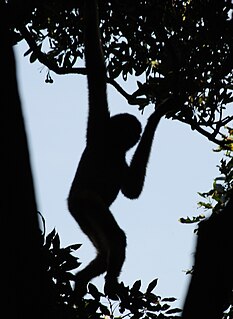
The Hainan black-crested gibbon or Hainan gibbon, is a Critically Endangered species of gibbon found only on Hainan Island, China. It was formerly considered a subspecies of the eastern black crested gibbon from Hòa Bình and Cao Bằng provinces of Vietnam and Jingxi County in Guangxi Zhuang Autonomous Region, China. Molecular data, together with morphology and call differences, suggest it is a separate species. Its habitat consists of broad-leaved forests and semi-deciduous monsoon forests. It feeds on ripe, sugar-rich fruit, such as figs and, at times, leaves, and insects.

The northern buffed-cheeked gibbon is a newly discovered species of crested gibbon which is found in Vietnam, Cambodia, and Laos. Its habitat is in the humid subtropical and seasonal tropical forests of these countries.
Stephen David Nash is an English wildlife artist who primarily specialises on primates. He is currently based at the Stony Brook University on Long Island, New York, USA, in the Department of Anatomical Sciences where he works as a visiting research associate.

The white-cheeked macaque is a species of macaque found only in Mêdog County in southeastern Tibet and Arunachal Pradesh in northeastern India. The white-cheeked macaque lives in forest habitats, from tropical forests to primary and secondary evergreen broad-leaved forests and mixed broadleaf-conifer forests. The species was first described by Chinese primatologists Cheng Li, Chao Zhao, and Peng-Fei Fan, in the American Journal of Primatology in 2015. It is one of twenty-three extant species in the genus Macaca, and the most recent to be formally described to science. While the species' exact conservation status has not yet been determined, it is likely threatened by poaching, deforestation, and increased human development of its habitat, much like the other primates which inhabit the area.
Tilo Nadler is a primatologist and the founder of Endangered Primate Rescue Center (EPRC), which is the first wildlife rehabilitation center in Indochina.
